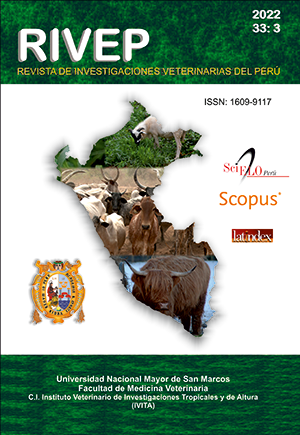The Pearson or Spearman Correlation in physical and textile traits of alpaca fibre
DOI:
https://doi.org/10.15381/rivep.v33i3.22908Keywords:
correlation, Pearson, Spearman, fibre, alpacaAbstract
The study aimed to determine Pearson's and Spearman's Correlation Coefficients, significances and confidence intervals, as well as to define the best procedure to determine the linear association relationship for fibre characters in Huacaya alpacas. A total of 22 543 alpaca fleece samples from the Puno Region, Peru was used. Variables that show physical and textile characteristics were analysed in each sample. Forty-five Pearson Correlation coefficients were determined for pairs of characters and the significance was determined by approximating the Student's t-distribution; confidence intervals were determined by Fisher's Z approximation. For the same data, Spearman's Correlation coefficients were determined, significance was obtained by standardizing Spearman's rs values to a Student's t value, the probability of significance was determined through the Student's t function for this coefficient, and confidence intervals were obtained by Ruben's approximation. An analysis of assumptions that confer accuracy to these coefficients and validity of their inferences was carried out. The values of r and rs were different, positive or negative. The absolute values of r and rs were in a range from 0.000 to 0.963, and from 0.003 to 0.977 as minimums and maximums, respectively. In both coefficients, the significance was mostly p<0.000. Confidence intervals were narrow for both coefficients. The values of the Pearson Correlation coefficients are greater than those of the Spearman, in greater proportion, for the same variable relations. Spearman's is more suitable for measuring the linear association relationship between physical and textile characters in alpaca fibre.
Downloads
Downloads
Published
Issue
Section
License
Copyright (c) 2022 Edgar Apaza Zúñiga, Samuel Cazorla Chambi, César Condori Carbajal, Fredy R. Arpasi Meléndez, Isabel Tumi Figueroa, William Yana Viveros, Jesús E. Quispe Coaquira

This work is licensed under a Creative Commons Attribution 4.0 International License.
AUTHORS RETAIN THEIR RIGHTS:
a. Authors retain their trade mark rights and patent, and also on any process or procedure described in the article.
b. Authors retain their right to share, copy, distribute, perform and publicly communicate their article (eg, to place their article in an institutional repository or publish it in a book), with an acknowledgment of its initial publication in the Revista de Investigaciones Veterinarias del Perú (RIVEP).
c. Authors retain theirs right to make a subsequent publication of their work, to use the article or any part thereof (eg a compilation of his papers, lecture notes, thesis, or a book), always indicating the source of publication (the originator of the work, journal, volume, number and date).



